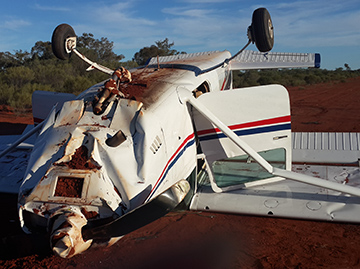- This accident highlights the risks associated with unsealed airfields.

The pilot and two passengers of a Cessna 182 aircraft suffered minor injuries, when the aircraft sank rapidly just before landing. It then landed heavily, bounced into the air, landed again, sank into soft ground, and flipped over.
The property where the airstrip was located had received about 100 mm of rain over a period of two weeks, which had stopped about a week prior to the accident. The surface of the runway appeared to be firm, but a soft layer extended beneath it. The hard landing combined with the soft surface led to the landing gear digging in and flipping the aircraft over. The pilot was unsure what had caused the aircraft to sink.
This incident highlights the importance of the identification and management of risks associated with unsealed airfields. Potential hazards such as changes in the runway surface following rain can be hard to detect. Changes in the runway surface can adversely affect the outcome of a hard landing.
Read the final report: Collision with terrain involving a Cessna 182, VH-AHC, 100 km south-west of Bourke, New South Wales, on 5 July 2015


